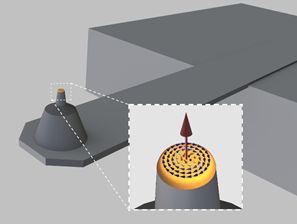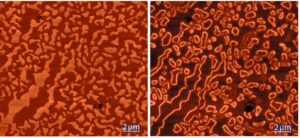New tip for magnetic force microscope

Magnetic Force Microscopy (MFM) is a technique that visualizes the distribution of a magnetic field of the sample with very high resolution. Our colleagues recently designed a new, more durable MFM tip with a magnetic vortex.
In standard MFM, a sharp tip covered with a thin magnetic layer is used, which is placed at the end of a flexible cantilever. During the measurement, the tip scans the sample surfaces in close proximity and responds to changes in the sample’s magnetic field. This tip-sample interaction is transferred into the form of small cantilever deflections, which are detected by the laser beam. In order to visualize the magnetic field very precisely, the tip apex is only 50-70 nm thin. However, such a sharp tip is quite fragile and prone to wear or breakage.
Our researchers form Micro-magnetics group at IEE SAS designed a new, more durable tip in the shape of a cylinder, with a ferromagnetic disk (FMD tip) placed on top of it. Such a disk has an interesting feature – it exhibits a magnetic vortex. This means that its magnetization is curved in the plane of the disk, however, in the core of the vortex, it emerges outside the plane of the disk. We use this very localized component of the disk magnetization to interact with the measured sample. The advantage is that the diameter of the vortex core is only 20 nm, so the tip provides good resolution. At the same time, it is characterized by better mechanical resistance and therefore, a longer life life. In previous works, we focused on the possibilities of improving the resolution of the FMD tip by means of vortex core stabilization and tested the tip on submicrometer magnetic domains. In the current work, we use the tip to scan large areas with larger domains and we find that the FMD tip provides a different type of magnetic map compared to commercial MFM tips. In the article, we compare different magnetic images and with the help of simulations we clarify the reason why the FMD tip mainly highlights the boundaries of the domain walls.

Figure: Magnetic maps of a sample with perpendicular magnetization obtained with a commercial MFM tip (left) and an FMD tip (right).
 Contact
Contact Intranet
Intranet SK
SK

